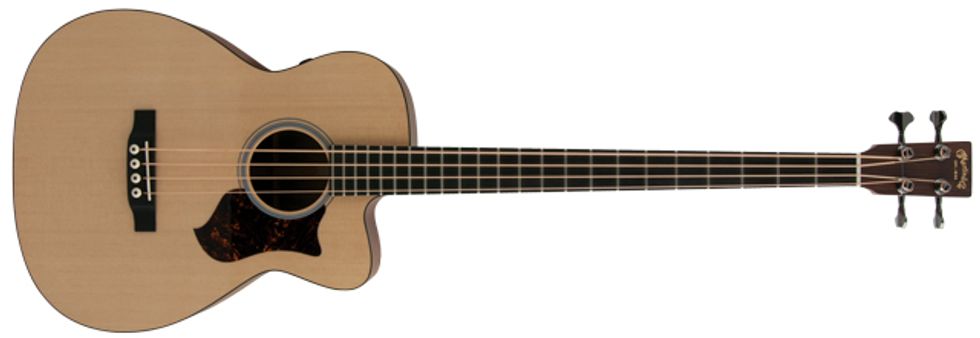The acoustic bass guitar is a peculiar breed. No matter how nice the instrument, most have a tough time competing unplugged against booming dreadnoughts at those backyard jams. And at a gig, even in the smallest of coffee shops? Don’t even think about it. You probably won’t be heard unless you plug in. Upright basses aren’t big just to be big— they need their girth to project lows.
Yet there’s a definite market for acoustic bass guitars, with most major acoustic guitar companies offering at least a few models. They don’t sound much like upright basses. (If they did, you’d see more upright players leaving their big buddy at home in favor of this lighter alternative.) But acoustic bass guitars tones sound woodier and more, well, acoustic; than those of standard electric basses. They can also provide a better stage aesthetic when everyone else in the band is working an acoustic instrument.
Which brings us to the BCPA4, a brand new acoustic bass guitar from C.F. Martin & Co.
Low-End Jumbolicious
The BCPA4 isn’t Martin’s first acoustic bass guitar, but it’s the first bass in the Performing Artist series the company introduced in early 2010. Like other instruments in the series, the BCPA4 subtly blends traditional and contemporary visual elements, is equipped with onboard Fishman electronics, and is intended as a stage- and studio-ready tool for working musicians.
Right out of its included hardshell case, the BCPA4 announces its presence via its jumbo-sized stature. Like many Martin’s instruments, the first impression is of top-line craftsmanship. The BCPA4 boasts solid tonewood construction, with back and sides of satin-finished sapele and a glossy polished top cut from tight-grained Sitka spruce. (Given Sitka’s reputation for stiffness and volume delivery, it’s a fitting choice for an acoustic bass guitar.) The body exudes a nicely understated elegance with its simple black Boltaron binding, a two-ring black-and-white rosette, and a Performing Artist-style pickguard that that departs from Martin’s traditional protective pieces.
The BCPA4’s select hardwood neck is capped by an unbound black ebony fretboard devoid of topside position markers, creating a clean, minimalist aesthetic. The headstock is dressed with a piece of East Indian rosewood with the Martin logo in gold foil. The black Gotoh tuners look anything but traditional, yet they suit the BCP4A’s subdued, elegant vibe.
An acoustic bass guitar can feel a little odd to players who have only played electric bass. Yet as a bassist with some acoustic-guitar background, I found the BCPA4 comfortable in both sitting and standing positions thanks to its 34" scale and familiar 1.58"nut width. The fret-dressing is excellent, and the satin-finished neck feels nice and fast. But this is a jumbo, definitely on the large side of the acoustic instrument spectrum.
Ratings
Pros:
Excellent build. Unplugged tones are fuller and louder than other basses in its class. A fun instrument for acoustic projects.
Cons:
At this price, it’s pretty spendy for an instrument that might be used only occasionally. As good as the unplugged tones are, most situations require plugging in.
Tones:
Playability/Ease of Use:
Build/Design:
Value:
Street:
$1,499
Martin
martinguitar.com
Add It Up
Since several Brian Ritchie bass lines are forever etched in my memory, I took a 1983 riff trip via a mini-set of Violent Femmes tunes. Unplugged and on its own, the BCPA4 sounded boomy, punchy, and full. It projected noticeably more volume than other acoustic basses I’ve played, and it sounded warmer than many of its thinner-sounding cousins. What was also pretty loud—and this is typical of acoustic bass guitars—was the string noise when fretting. As on an acoustic guitar with a fresh set of strings, expect squeaks, especially on this large instrument with its fat strings.
When I plugged the BCPA4 into a Gallien-Kreuger 800RB driving a TC Electronic RS410 cab, it became a different animal altogether. Naturally, it sounded less acoustic, but the onboard Fishman F1 Analog system gives the BCPA4 an honest chance of being heard.
The F1 Analog system is good aesthetic fit for the BCPA4. Residing on the upper bout with just simple rotary volume and tone controls and a circular LED, the simple system allows for plug-and-play set up with ample tone control. It also boasts a very functional chromatic tuner accessed by press/holding the volume knob. The tone knob doubles as a phase control that improves bass response at low volumes and suppresses feedback at high volumes. Just press and release it several times until you get to the position that works best for you.
For the cleanest noise-free sound, the manual suggests setting the BCP4A volume knob as high as possible without causing the amp to distort. (I dialed it up to about 80 percent before encountering sounds I didn’t want to hear.) The single tone knob provides an impressive sweep. Turning the EQ off in the fully counter-clockwise position offers the woodiest, most organic-sounding tones. Advancing the tone knob cuts mids while emphasizing highs and lows—a tone that’s a bit more precise than the fully counter-clockwise setting.
The Verdict
The Martin BCPA4 is a fine instrument. The craftsmanship is just what you’d expect from Martin. The playability is sweet. It can serve up nice, woody tones via its simple but effective onboard preamp. Unplugged, it’s one of the loudest and fullest-sounding acoustic basses I’ve tried. At $1,500 it’s not inexpensive, especially if it’s only going to make occasional appearances at gigs. But for the right player and setting, this fun-to-play, first-in-class rumble box has much to offer.








![Rig Rundown: AFI [2025]](https://www.premierguitar.com/media-library/youtube.jpg?id=62064741&width=1245&height=700&quality=70&coordinates=0%2C0%2C0%2C0)












 Shop Scott's Rig
Shop Scott's Rig

![Rig Rundown: Russian Circles’ Mike Sullivan [2025]](https://www.premierguitar.com/media-library/youtube.jpg?id=62303631&width=1245&height=700&quality=70&coordinates=0%2C0%2C0%2C0)













































